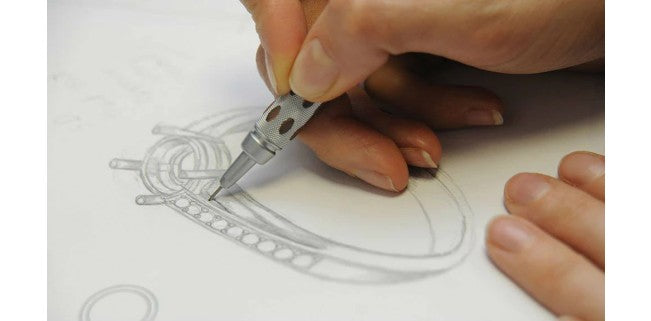How Are Diamonds Cut Using Other Diamonds?

What do you see in your mind when you think of a diamond? If you're like most of us, you think of a gem that's perfect in every way — right down to its signature shape. What you probably don't realize, however, is that diamonds aren't perfect when they're plucked from the mines. These rough diamonds are then cut into the styles we know and love.
Diamonds are graded based on the 4 Cs — including cut — but the actual step-by-step process of how its done is pretty much a mystery to most of us. How are diamonds cut exactly? Let's break it down.

TABLE OF CONTENTS
Diamonds are Cut in Two Ways
Fun fact: Diamonds can only be cut with diamonds. The reason? Diamonds are some of the hardest materials on earth, so the tools they use to do it are usually diamond bladed on the edges or have an edge of diamond dust.
But before they're cut, a master diamond cutter evaluates the stone for its inclusions — AKA flaws — and carat weight. From there, the cutter then determines whether it's shaped using a step cut or a brilliant cut.
Most of the time, a rough diamond is in a octahedron shape, meaning it has eight faces, twelve edges and six vertices. In plain English: It's the perfect shape for a brilliant cut because it won't lose too much carat weight in the process — and it'll shine brightly in the light.
A step cut is typically done on a diamond to create a square or rectangular shape that features eight lines running parallel along both the length and width of the diamond, drawing the eye to the center of the stone and give the illusion that it has “steps,” hence the name. While step cut diamonds don't shine as brightly as brilliant cut diamonds, they are typically clearer.
The Actual Diamond-Cutting Process
So, how are diamonds cut? It's a complicated process that's typically broken down into five steps by a qualified diamond expert: planning, cleaving, bruting, polishing and inspecting.
- Planning. The first step is almost always the most important — and that's especially true for diamond cutting. Planning a diamond cut determines so much of how a diamond turns out because a number of details, including shape and size, is decided at this point. The diamond cutter uses his or her expert knowledge, along with computer software, to map the rough diamonds to help make it the best it can be (without sacrificing too much of the diamond in the process).
- Cleaving. In this step, the diamond cutting expert splits the rough diamond into separate pieces. Cleaving is typically done with mechanical saws or contactless lasers to keep the diamond in tip-top shape.
- Bruting. Also called girdling, bruting takes the separated rough diamonds and turns them into round stones by placing them on a spinning axle and grinding them against each other to create the rough finish.
- Polishing. This is technically a two-step process that involves taking the round shape and turning it into a diamond, complete with the smooth and reflective facets we know and love in our diamonds. The first step of polishing, blocking, involves creating the pavilions, crowns, culets and facets of the diamond. This creates the base for the next stage, brillianteering. During this process, the diamond's remaining facets are added, then the brilliance and fire of the diamond is decided.
- Inspecting. Though it sounds similar, the diamond cut inspecting process is not the same as diamond grading. Instead, this step involves thoroughly checking the diamond to make sure it meets the right specifications. If it does, it's passed on and eventually sold. If not, it's sent back to polishing for touch-ups.
What Happens After a Diamond is Cut?
Once a diamond is cut, it's then sent to gem experts to receive a grade based on its 4 Cs — including the cut.
While you can buy diamonds without a grade, it's not the best choice. At With Clarity, every diamond we sell comes with a GIA grading report or an IGI grading report so you'll know everything about your diamond — and you can ensure you have what you paid for. Shop with confidence and with clarity.









